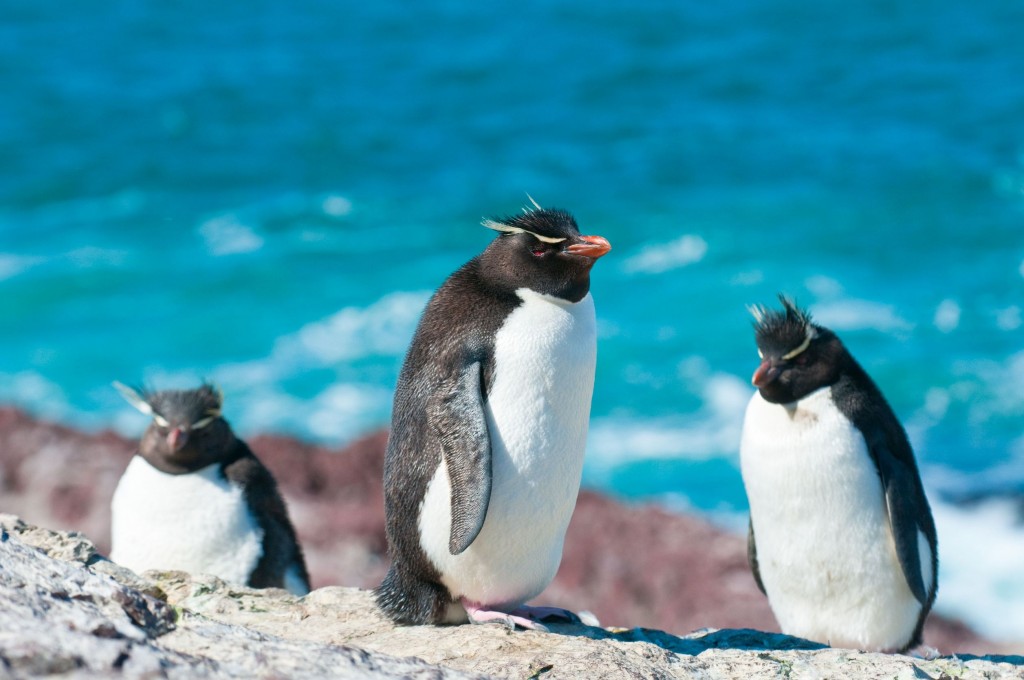On the Ría Deseado’s north shore, Puerto Deseado (pop. 15,000) is 216 kilometers southeast of Caleta Olivia and 295 kilometers from Comodoro Rivadavia via RN 3 and paved RN 281 (but 126 kilometers from the RN 3 junction).

Rockhopper penguins on the Isla de los Pingüinos. Photo © Javarman Javarman/123rf.
For a small town, Deseado has plenty to see. The big draw is the Reserva Natural Ría Deseado, but various historical monuments all have good stories behind them.
By the late 19th century, Deseado seemed destined to become a rail port, as authorities planned a northwesterly freight-and-passenger line to Bariloche. It never advanced beyond Las Heras, 283 kilometers north-west, and closed in 1977, leaving the stately Estación del Ferrocarril Patagónico (Eufrasia Arias s/n, tel. 0297/4870601, 8am-2pm and 4pm-7pm Mon.-Fri., 4pm-7pm Sat., free but donations encouraged) as a surprisingly good museum staffed by former railroad workers.
Several monuments date from this era, most notably the railroad’s 1898 Vagón Histórico (corner of San Martín and Almirante Brown), a historical railcar in a small plaza. Immediately across the street, Banco de la Nación has preserved its classic lava-block style. The former Compañía Argentina del Sud (1919) now hosts a supermarket that has sadly concealed its vintage details with painted signs on all sides. One block west stands the Sociedad Española (1915).
Along the waterfront, the Museo Regional Mario Brozoski (Colón and Belgrano, tel. 0297/4871358, 1pm-7pm daily in summer, 10am-5pm daily the rest of the year, free) holds artifacts from the English corvette Swift, sunk nearby in 1770 and rediscovered in 1982. Four kilometers northeast, Balneario Las Piletas is a volcanic beach area where retreating tides leave pools warm enough for swimming, at least in summer.
One of coastal Patagonia’s prime wildlife sites, the Ría Deseado submerges a long narrow valley that once carried more fresh water. As the fresh water flow diminished, seawater penetrated farther and farther inland, creating new islands and other fauna-rich habitats.
Several operators organize wildlife-watching excursions in and around the ría (estuary) to locations such as the Magellanic penguin colonies at Isla Chaffers and Isla de los Pájaros, and cliff-side colonies of rock cormorants and gray or red-legged cormorants at Barranca de los Cormoranes, where deep water permits close approach to the nests. On any excursion, swiftly swimming toninas overas (Commerson’s dolphins) breach and dive around and under the outboard launches. In mating season, they leap out of the water. Some operators also follow Darwin’s route up the ría where, the great naturalist wrote, “I do not think I ever saw a spot which appeared more secluded from the rest of the world, than this rocky crevice in the wild plain.”
In handsome quarters that include a sea-view café, Darwin Expediciones (España 2551, tel. 0297/15-6247554) has extensive experience here and also does sea kayaking. Half-day trips (US$38 pp with a six-passenger minimum) run along the Ría Deseado; full-day trips (US$100 pp with a six-passenger minimum) follow Darwin’s estuary route.
Puerto Penacho (tel. 0297/15-4058472) does similar maritime itineraries, and Turismo Aventura Los Vikingos (Estrada 1275, tel. 0297/4870020) adds other overland excursions to the usual nautical journeys.
Created in 2011, this park protects the wildlife-rich seashores south from Ría Deseado to Bahía Laura and several small offshore islands, including Isla Pingüino. Exploited until the 19th century for its populous sea lion colonies, this 1.25-square kilometer island about 20 kilometers southeast of Deseado has breeding sea lions, occasional elephant seals, two species of skuas and their hybrids, and the world’s northernmost colony of the tireless rockhopper penguin, which braves crashing waves up steep stone faces to reach its nesting sites.
For full-day boat excursions to Isla Pingüino (about US$90 pp with a six-passenger minimum), contact Deseado operators Darwin Expediciones (España 2551, tel. 0297/15-6247554), Puerto Penacho (tel. 0297/15-4058472), and Turismo Aventura Los Vikingos (Estrada 1275, tel. 0297/4870020).
From the Terminal de Ómnibus (Sargento Cabral 1302), about 10 blocks northeast of downtown, there are buses to Caleta Olivia (US$20, 3 hours) and Comodoro Rivadavia (US$27, 4.5 hours) with La Unión (tel. 0297/4870188, three buses daily) and Sportman (tel. 0297/4870013, two buses daily).
Excerpted from the Fourth Edition of Moon Patagonia.